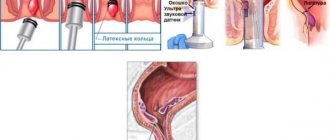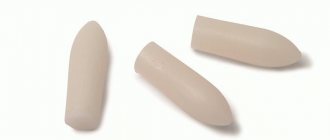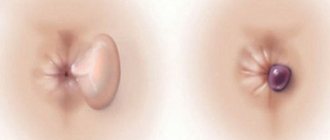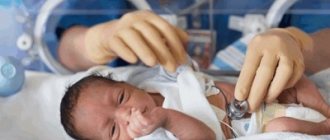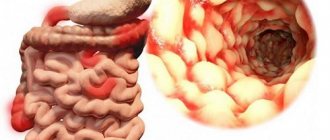Why do hemorrhoids appear after cesarean section?
Neither vaginal birth nor cesarean section stimulates the spontaneous appearance of hemorrhoids. An exacerbation of this delicate pathology occurs after surgery in those women in labor who suffered from hemorrhoids while pregnant.
This phenomenon occurs everywhere and is caused by the structure of the body and hormonal changes.
- A heavy uterus puts pressure on organs and blood vessels.
- The blood supply to the pelvic area is disrupted.
- Due to high pressure, blood in the veins stagnates.
- The hormone progesterone helps reduce the tone of the vascular walls.
- The intestines stop working adequately, and constipation occurs.
Due to the fact that bed rest is indicated after the operation, stagnation processes provoke the formation of hemorrhoidal cones, and disturbance of the bowel movement leads to their damage and inflammation. Therefore, during rehabilitation after cesarean section, hemorrhoids worsen.
Associated causes of the problem
Hemorrhoids after cesarean section also occur due to concomitant factors. It is necessary to understand that a cesarean section is a full-fledged surgical intervention.
After the operation, the woman has several stitches placed on three layers of tissue. The main problem lies in the sutures placed in the uterine cavity. Due to the presence of this damage, the patient needs a long recovery. It is required to avoid increased physical activity for a while. It is also not recommended to strongly strain the muscle layer of the abdominal area. Doctors prohibit high physical activity. In the absence of these actions, concomitant causes of the development of hemorrhoids arise:
- relaxation of the intestines;
- decreased blood circulation in the pelvis;
- postpartum constipation;
- hormonal changes.
Relaxation of the intestines occurs due to the action of the anesthetic substance. After a cesarean section, the anesthetic drug is washed off within a few days. At the same time, the weakening of the contractile function of smooth muscles remains. The functioning of the intestinal tract temporarily needs to be restored. For this reason, some patients experience hemorrhoids in the first week after a cesarean section.
Pathology is also detected due to postpartum constipation. Constipation is also a consequence of weakened intestinal functions. The surface of the rectum has special cells that draw a certain amount of fluid from digested food. After cesarean section this function is enhanced. The removal of large amounts of moisture from the masses leads to the formation of hard feces. It cannot move correctly and quickly through the intestines due to a decrease in its secretion. The accumulation of masses leads to constipation. If a delicate problem is not addressed in a timely manner, the risk of developing hemorrhoids increases.
A decrease in physical activity is accompanied by a slowdown in blood circulation in the pelvis. Blood is the main source of oxygen. Oxygen is involved in metabolic processes. Thanks to metabolism, the formation of young cells of various tissues occurs. The loss of this function is accompanied by a decrease in the activity of the large vessels of the small pelvis. Fluid retention in the vessels leads to the formation of lumps.
Additional factors
One of the associated causes of hemorrhoids after cesarean section is hormonal changes. The onset of natural labor is accompanied by a decrease in the amount of progesterone and an increase in oxytocin. Oxytocin causes natural contractions to develop. The hormone helps the uterus begin contractile activity. Caesarean section excludes this property of the hormonal system. For many patients, surgery is scheduled two weeks before the estimated due date. At this stage, oxytocin is not produced.
After surgery, progesterone levels are maintained. The body begins to rebuild gradually. Progesterone keeps muscle tissue relaxed. Thanks to this feature, the intestinal walls remain in a relaxed state.
All these reasons can cause the appearance of hemorrhoidal bumps. In order for a woman to promptly determine the development of the problem, she needs to know the symptoms of the disease.
Symptoms of hemorrhoids after cesarean section
Due to bed rest and inactivity of the woman in labor after a cesarean section, hemorrhoids occur, and blood accumulates in the vessels that are located under the rectal mucosa. If a woman has a predisposition to varicose veins, she should take a close look at the first possible symptoms of such a delicate disease as hemorrhoids:
- aggravating sensations in the anal area;
- pain during bowel movements;
- itching and burning in the rectum;
- irritation of the rectum due to inflammation of hemorrhoids;
- constipation;
- pulling pain in the lower abdomen.
After surgical childbirth, the woman in labor is advised to rest. She moves little for some time, and this leads to the fact that the blood flow to the pelvic organs increases and the outflow is disrupted. The situation is aggravated by the fact that the depressed digestive system does not allow optimal evacuation of feces, which leads to constipation, which contributes to the exacerbation of hemorrhoids, the loss of hemorrhoidal cones, their irritation and rupture. If bowel movements are accompanied by bleeding from the anus, this indicates that the disease has become acute. This is fraught with consequences such as anemia and internal bleeding. The problem can be solved surgically, so it is important to prevent such situations and consult a doctor in time.
Do you prefer traditional medicine?
Not really
After a caesarean section, a new mother is primarily concerned with her child, so she may often simply not notice the first signal of the disease. In addition, many women are embarrassed to talk about such things and leave the problem to chance. The disease cannot be allowed to develop. You should pay close attention to your health, especially after childbirth, because not only the mother’s condition, but also the baby’s comfort depends on it.
Causes
After surgery for cesarean section, there is a high risk of hemorrhoids. This is due to the fact that dilation of blood vessels in the rectum develops in most women during pregnancy.
Indeed, during pregnancy, a woman’s body undergoes increased stress, which adversely affects the condition of blood vessels.
During the postpartum period, with a cesarean section, women should be in a supine position on the first day. This leads to stagnation of blood in the pelvic organs and overfilling of blood vessels, and accordingly, an exacerbation of the disease occurs.
During cesarean delivery, adynamia increases the likelihood of developing constipation. This is also a predisposing factor to exacerbation of hemorrhoids, especially after cesarean section.
During cesarean delivery, adynamia increases the likelihood of developing constipation. This is also a predisposing factor to exacerbation of hemorrhoids.
Development of hemorrhoidal cones after cesarean section
Due to increasing pressure on the blood vessels of the rectum and impaired blood flow, the veins are deformed under the influence of blood. They are located directly under the mucous membrane, have thin walls, which, among other things, become less elastic after a cesarean section. Blood accumulates in the veins, forming hemorrhoids. At these first signs you should consult a doctor.
If this stage is ignored, hemorrhoids will move on to the next stage of development:
- At the first stage, the vessels only fill with blood, thicken and become inflamed. A feeling of heaviness in the rectum, pain during bowel movements, and bleeding during bowel movements are the main signals at this stage of hemorrhoid development.
- The second stage of development of hemorrhoidal cones is characterized by their prolapse from the rectum. But they can still adjust on their own. In this case, the pain intensifies, accompanied by burning and itching. Blood is released with the stool, and an anal fissure appears.
- The pain becomes even stronger, tormenting not only during bowel movements, but also after it. Enlarged hemorrhoids fall out, but cannot be reduced without assistance.
- During the fourth stage, fallen lumps cannot be straightened even with the help of a proctologist. It is very dangerous to allow hemorrhoids to develop into this state, as the risk of thrombosis and severe bleeding is high.
Due to the fact that after a cesarean section a woman’s immunity is weakened, infection easily penetrates into damaged hemorrhoids. As a result, inflammation and infection of the genitourinary system may occur. The most dangerous complications include thrombosis, which has a risk of developing into sepsis. This is fraught with severe swelling, necrosis and blood poisoning.
Prevention of chronic hemorrhoids
With proper treatment, hemorrhoids are a fixable matter, but expensive and unpleasant for a woman. It is worth taking care of prevention in advance - before childbirth.
- Pay attention to your diet;
- Take vitamins;
- Use herbal decoctions and infusions for constipation;
- Spend time doing yoga, Pilates, and morning exercises;
- Take a walk in the fresh air;
- Take active breaks during a sedentary lifestyle;
- Maintain personal hygiene.
Before childbirth, after a cesarean section, one wash a day is not enough. Rinse the anal area after bowel movements. Use soft toilet paper.
If you take measures and follow the instructions of your doctor, you will avoid postpartum hemorrhoids and prolonged treatment.
Is hemorrhoids an indication for cesarean section?
Hemorrhoids overtake a pregnant woman in the second or third trimester. The fetus develops, grows, and with it the load on the veins increases. Sometimes the first stages of the disease may be asymptomatic, but if a pregnant woman notices specific signs of the disease, a logical question arises: is hemorrhoids a medical indication for a cesarean section? Expectant mothers are frightened by the fact that during childbirth, strong stress can cause an exacerbation of the pathology. However, regardless of the method of delivery, if the problem begins during pregnancy, then the likelihood that it will worsen after childbirth is very high.
After surgery, the risk of developing the disease is higher. This is due to the fact that natural childbirth is accompanied by a short rehabilitation period. The woman almost immediately begins to move independently, breastfeed and care for the baby. After surgery, mandatory bed rest follows, and this contributes to stagnation in the blood vessels. We can talk about hemorrhoids as an indication for cesarean section only if by the time of birth the disease has reached the fourth stage. In this case, you can avoid heavy stress and possible complications.
Reasons for enlargement of hemorrhoids after CS
A caesarean section is an operation that eliminates the intense pain of childbirth without requiring as much physical exertion. But, of course, CS is not a complete panacea for hemorrhoids, and it may well appear in a woman after it, or worsen. Why does this happen? And if hemorrhoids do appear after a cesarean section, how to treat it?
CS as a way to prevent the development of hemorrhoids
Pregnancy itself can become one of the causes of hemorrhoids due to mechanical compression of the vessels of the large intestine and rectum. In addition, pregnant women often experience constipation, which is provoked by an increased amount of female hormones (progesterones) in the body during this period. They, to a certain extent, inhibit the functioning of the gastrointestinal tract, and also relax the walls of blood vessels.
And therefore, many women, especially in the last two-thirds of pregnancy, suffer from hemorrhoids. In addition, excess body weight, poor nutrition, physical inactivity or improper physical activity are also stimulators of this pathological process.
As for the CS, this operation, despite relieving the woman of the birth process and the associated overloads, has a number of negative effects on the body. First of all, it disrupts the functioning of defense mechanisms. And this can also be one of the factors contributing to the development of hemorrhoids. This is especially likely in women who have congenital disorders of the normal structure of blood vessels. After the CS, the woman must observe strict bed rest for several days. If she already suffered from hemorrhoids before the operation, then due to the forced lack of movement in the blood vessels of the intestine, blood stagnation may occur. And hemorrhoidal cones (nodes) increase in size, causing pain and discomfort to the woman.
Based on the symptoms that appear, one can judge at what stage the development of this pathological process is.
- Stage 1. Lumps or nodes are located inside, on the intestinal walls, and do not fall out. At times, symptoms such as itching, bleeding, and pain are noted.
- Stage 2. After physical exertion or with strong straining during bowel movements, the nodes may fall out, but then they are set. And therefore it is not always possible to detect them.
- Stage 3. Lumps or nodes after prolapse do not move back into the anus. You can set them with your fingers, but they fall out again even with very little tension.
- Stage 4. The symptoms described above are accompanied by complications: an inflammatory process and thrombosis may occur.
Treatment of hemorrhoids after cesarean section
To cure hemorrhoids, you must consult a doctor. Self-medication can be ineffective and dangerous for the health of mother and baby. Breastfeeding places certain restrictions on drug therapy, and fresh stitches eliminate physical activity. But a specialist will tell you how to properly treat hemorrhoids, especially after a cesarean section, in order to protect the patient and her baby as much as possible from unpleasant consequences.
Bed rest
The rehabilitation stage requires the woman to remain strictly in bed. This can cause congestion in the blood vessels and worsen the situation. To avoid this, it is necessary to ensure that the patient is positioned so that her lower body is higher than her upper body. In this case, you should place a bolster or pillow under your pelvis and legs. This position will ensure the outflow of blood from the pelvic organs and reduce pressure on the vessels.
If the caesarean section went without complications, then after a day the doctor may advise you to get out of bed and move around within the ward. In the future, as the mother’s condition improves, light exercises are used. The most common is Kegel gymnastics. It consists of rhythmic contraction of the muscles of the perineum. Such exercises strengthen the muscles and walls of blood vessels and can be performed without getting out of bed. But in order for the treatment of hemorrhoids to be more effective, proper bed rest should be combined with light exercise (recommended by a doctor) and the necessary medications.
Drug treatment
What medications a doctor will prescribe for the treatment of hemorrhoids depends on whether the woman is breastfeeding her baby. If breastfeeding occurs, then the list of medications that can cure the disease is significantly reduced. Please pay attention to the following recommendations:
- It is necessary to be very careful when choosing medications, because many of them are contraindicated when feeding. This is due to the fact that some components of the drugs cause allergies in the child.
- For a nursing woman, topical medications are more suitable: suppositories or ointments for hemorrhoids. They have less impact on the child’s body and are therefore safer.
- It is better to give preference to medications based on natural ingredients.
- You need to get rid of constipation. To do this, use lactulose laxatives or microenemas, which soften hardened stool. Sometimes a regular enema may be necessary. It is best to prepare it using medicinal herbs. You should not overuse enemas, as they help wash out the intestinal microflora. This is fraught with the formation of even more severe constipation.
- To prevent constipation, it is necessary to adjust your diet. To do this, you need to eat as much fiber as possible, drink clean still water in a volume of about two liters.
- You can use herbal baths. The best choice is string and chamomile.
Surgical intervention
If hemorrhoids have reached a severe stage, surgical intervention is used to treat them. Such therapy causes certain difficulties for a nursing woman, since the use of many anesthetics is unsafe for the baby.
Most often, in this case, minimally invasive techniques are used, including:
- Laser removal of hemorrhoidal cones.
- Freezing nodes with liquid nitrogen.
- Latex rings for tying knots.
In order not to resort to surgical treatment of hemorrhoids, you need to consult a doctor when the problem is not yet of such a large-scale nature.
Rehabilitation
In order to avoid the development of hemorrhoids as effectively as possible after a cesarean section, you need to start moving quickly. If the doctor allows it, then within a day after the operation you should get out of bed and move around the room. It is necessary to resume movements gradually, starting from a flat surface. You can resort to special light aerobics, exercises, yoga after removal of stitches, aimed at eliminating delicate problems.
The safest components that will help cope with hemorrhoids are considered to be medicinal herbs. They can be used as baths, compresses, microenemas. You just need to remember that herbal medicine is effective as an additional treatment, and before using it, you also need to consult a doctor.
What can you do after surgery?
During the postoperative period, a pregnant woman is on bed rest for several days. In the absence of physical activity and movement, the course of the disease can become complicated due to the formation of stagnation. To prevent this, you need to change your body position. The lower part of the body needs to be raised; for this, a pillow must be placed under the legs and pelvis. Thus, the blood flow will be directed away from the pelvic organs and nodes. This fact will alleviate the condition and eliminate stagnation.
Even while in bed, a woman can perform simple exercises. You can strengthen the sphincter and buttock muscles by periodically squeezing them.
It is very important that a woman not be bothered by constipation. Hard feces can injure the nodes. It is necessary to organize nutrition; it is important that fiber is present in a woman’s diet; it is found in vegetables and cereals.
If constipation does occur, you must take the following medications:
- Duphalac;
- Lactusan;
- Senade.
These products are safe for nursing mothers. Treatment of constipation should be carried out using natural rectal suppositories made on the basis of:
- shark liver;
- propolis;
- mumiyo;
- cacao butter;
- sea buckthorn.
Sometimes you can do enemas with herbs, but often you don't need to resort to them. Otherwise, the intestinal microflora will be disrupted, which in turn will again lead to constipation.
Your doctor will tell you how to treat constipation. He will select the necessary therapeutic complex.
Pain that occurs during an exacerbation can be eliminated with ice. Ice reduces spasms and stops bleeding, freezing the nerve endings, it relieves pain. Ice should be applied to the affected areas for a short time.
After the adaptation period has passed, the woman will need to periodically perform simple physical exercises. It is useful to perform exercises while lying on your back. Such exercises include the well-known “bicycle” and “scissors”.
General preventive actions
To avoid hemorrhoids, first of all, you need to pay attention to the prevention of stagnation and treatment of constipation. To do this, you need to pay attention to your diet. Your diet should include foods rich in vitamins and fiber. These are vegetables, fruits, natural juices, cereals. Vegetable oils will help cope with the problem: olive, sunflower, sesame. Dried fruits, especially figs, prunes, and dried apricots, have a good laxative effect.
You need to drink enough water. For prevention, you can drink one and a half liters, and if the problem is obvious, then the amount of water can be increased to two liters.
An active lifestyle will help you avoid constipation. Despite the fact that in the last months of pregnancy it is difficult for women to move a lot, they should not lie on the sofa all the time. After a caesarean section, active actions should be approached carefully and with the permission of the doctor.
The nervous regulation of the intestines often suffers from stress. If stressful situations happen frequently in your life, you should think about solving this problem. It is difficult for a pregnant woman, like a new mother, to cope with emotions, but she must try to avoid impaired intestinal motility. Perhaps it is worth adjusting your own strategy for dealing with stress, talking more often about disturbing topics with loved ones, who should understand how much their support is needed during such a difficult period in the life of a young mother.
Daily and nutritional schedules are very important in order to track and establish regularity of bowel movements. To start your metabolism, you need to drink a glass of clean water in the morning. If a woman is not breastfeeding and is not prone to allergies, you can dilute a spoonful of honey in water. This will help start the digestion process and cause the urge to defecate.
Stool should be daily. This needs to be monitored. In case of delay, it is better not to start the process and take action immediately.
If a woman still suffers from constipation and all of the above methods are not able to quickly relieve her of her suffering, it is better to use mild laxatives. Their choice should depend on whether she is breastfeeding her baby.
As a last resort, you need to do a regular enema. However, it is worth remembering that this procedure should not be performed frequently, as this can lead to chronic constipation.
Treatment
The main problem that the doctor faces during the postoperative period of cesarean section is how to treat the disease if the woman is breastfeeding. Medications are absorbed into the blood, then pass into the milk and harm the baby. It is much easier when the newborn is bottle-fed. Then you can treat with any medications.
Medications during lactation for hemorrhoids
During the postoperative period of cesarean section, the patient should try to keep the upper part of the body higher than the lower part. This helps to drain blood away from the pelvis and not put pressure on the hemorrhoids. It is also necessary to consume special foods (fermented milk, containing fiber, etc.) and laxatives (exclusively under the supervision of a doctor) in order to prevent the formation of constipation.
When the adaptation period after a cesarean section ends, it is necessary to begin treating hemorrhoids. You can perform simple physical exercises every day that will not damage the sutures and will help improve the condition of hemorrhoids. If the patient does not recover and the condition worsens, it is necessary to treat the disease using other methods.
Paying attention to the fact that a woman after a cesarean section is weakened, and the body’s ability to fight the disease is deteriorated, the following treatment methods are distinguished:
Medicinal method of combating hemorrhoids
- medicinal;
- surgical intervention.
For a woman who is feeding a baby, the doctor mainly prescribes suppositories and ointments for the anal area or safe painkillers. They contain mainly natural ingredients: sea buckthorn oil, cocoa, propolis, calendula and other homeopathic components. They help relieve inflammation and pain. All drugs are prescribed under the strict supervision of a specialist, as there is a risk of harming the child.
If drug therapy does not bring the desired results, and the disease only worsens, hemorrhoids after cesarean section and pregnancy become chronic or stage 3-4, the doctor proceeds to surgical intervention.
During surgery, both external and internal hemorrhoids are removed. These operations do not cause severe injury or pain. Types of surgical operations:
- sclerotherapy;
- photocoagulation;
- dressing with latex rings.
The first type involves the penetration of a special substance into the node, which leads to its reduction by reducing blood flow. Then they go back inside. The second type involves cauterization of blood vessels that are bleeding. Due to this, they are fixed to the intestinal wall and become smaller. As a result of the third method, blood circulation in the node stops, and it gradually dies, usually on days 8-11.
Diet for hemorrhoids
After the operation, certain recommendations should be followed that can prevent recurrence of the disease in the future. Following a diet and constant preventive exercises at least during the first 3 years will lead to complete recovery.
What do doctors think?
At the first suspicion of hemorrhoids during pregnancy or after a cesarean section, you cannot ignore the problem; you should immediately consult your doctor. With its help, you can cure the disease at the first stage and avoid surgical intervention and complications after hemorrhoids.
Advanced pathology can cause internal bleeding, anemia, thrombophlebitis, infection and sepsis. You cannot be ashamed of this problem, try to cure it yourself and let the disease take its course. Such an irresponsible attitude towards one’s health can also harm a newborn, who in the first days of life depends on the mother’s immunity.
Unqualified self-medication with medications that are incompatible with breastfeeding can give the baby allergies with serious consequences. It is especially important to monitor your stool and well-being for those women who are prone to varicose veins, because they are most susceptible to hemorrhoids.
